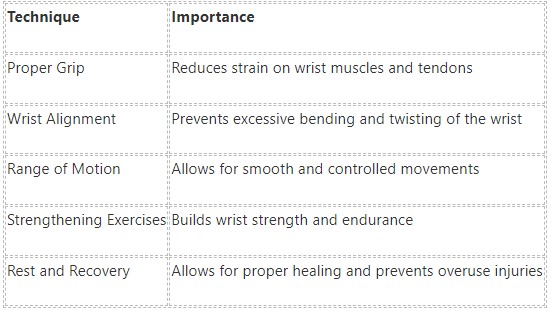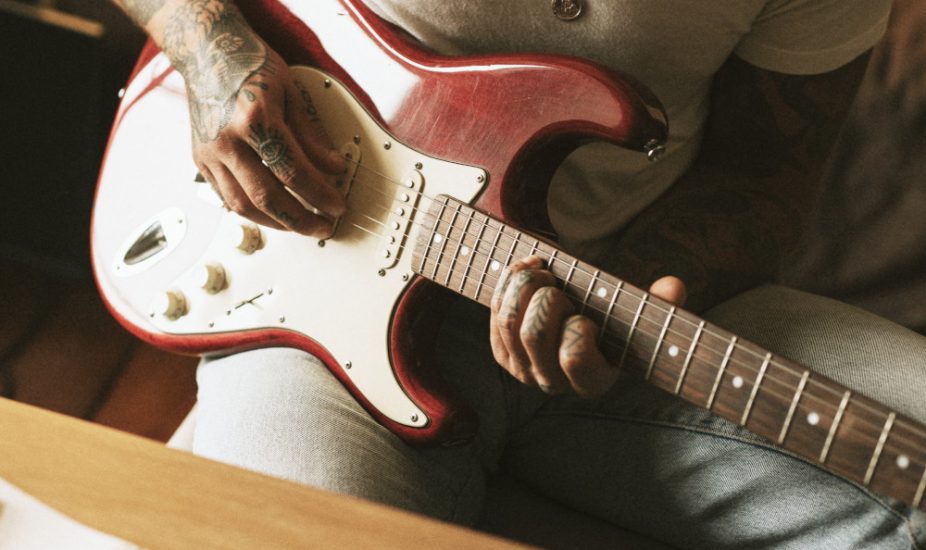Are you experiencing wrist pain while playing the guitar? Don’t worry, we’ve got you covered. In this article, we will provide you with valuable tips and techniques to help you manage and alleviate guitar wrist pain. From understanding the causes of wrist pain to choosing the right guitar and adopting the proper technique, we will cover all aspects of maintaining wrist health as a guitarist. Whether you’re a beginner or an experienced player, these tips will help you strum without the pain. So let’s dive in and learn how to keep your wrists healthy while pursuing your passion for music.
Playing the guitar can be a source of wrist pain and discomfort if proper care is not taken. Wrist health directly affects a guitar player’s ability to play and enjoy the instrument. In this article, we will explore the causes of guitar wrist pain, the symptoms to watch out for, and various strategies to prevent and manage wrist pain.
Key Takeaways
- Guitar wrist pain can be caused by a variety of factors, including poor technique, overuse, and underlying medical conditions.
- Symptoms of wrist pain may include stiffness, swelling, and aching in the wrist and forearm.
- Proper technique, including wrist positioning and hand placement, prevents wrist pain while playing guitar.
- Choosing the right guitar, including considering the size and weight, can also help prevent wrist pain.
- Exercises and stretches, as well as proper posture and ergonomics, can strengthen the wrist and prevent pain.

Understanding the Causes of Guitar Wrist Pain
Several factors can contribute to wrist pain in guitar players. One common cause is repetitive strain injuries (RSIs), which occur when the same motion is repeated over and over again, leading to inflammation and damage to the tendons and muscles in the wrist. Poor technique is another culprit, as improper hand and wrist positioning can put unnecessary strain on these areas. Overuse, such as practicing for long hours without breaks, can also lead to wrist pain. Arthritis, a condition characterized by inflammation of the joints, can affect guitar players and cause wrist pain.
Symptoms of Wrist Pain to Watch Out For
Guitar players need to be aware of the symptoms of wrist pain so that they can take appropriate action. Pain is the most obvious symptom, and it can range from mild discomfort to severe agony. Swelling may also occur in the affected area, making it difficult to move the wrist freely. Stiffness is another common symptom, which can make it challenging to play the guitar with ease. Numbness or tingling sensations in the fingers or hand may also be experienced, indicating nerve involvement.
The Importance of Proper Technique in Preventing Wrist Pain

You can prevent wrist pain in guitar players by proper technique. Correct hand and wrist positioning can help distribute the force evenly across the joints and muscles, reducing strain. It’s important to keep the wrist in a neutral position, avoiding excessive flexion or extension. Using the right amount of tension is also important – gripping the guitar too tightly can lead to unnecessary strain on the wrist. By practicing good technique, guitar players can significantly reduce their risk of developing wrist pain.
How to Choose the Right Guitar for Your Wrist Health
Choosing the right guitar is an important consideration for maintaining wrist health. Factors to consider include the size and weight of the instrument, as well as the width and shape of the neck. It’s important to find a guitar that feels comfortable and natural in your hands, as this will help prevent unnecessary strain on the wrists. Different types of guitars, such as acoustic, electric, and classical, can also have an impact on wrist health. Electric guitars tend to have thinner necks and lighter bodies, which can be more comfortable for some players.
Exercises and Stretches to Strengthen Your Wrist and Prevent Pain
Regular exercise and stretching can help strengthen the muscles and tendons in the wrist, reducing the risk of pain and injury. Wrist curls are a simple exercise that can be done with a dumbbell or resistance band. Finger stretches, such as extending and flexing each finger individually, can also help improve flexibility and reduce stiffness in the wrist. Hand grip exercises, such as squeezing a stress ball or using a grip strengthener, can strengthen the muscles in the hand and forearm.
Tips for Proper Posture and Ergonomics While Playing Guitar
Proper posture and ergonomics are essential for maintaining wrist health while playing the guitar. Whether sitting or standing, it’s important to maintain a relaxed and upright posture. The guitar should be positioned so that it is comfortable to play without straining the wrists or shoulders. Adjusting the guitar strap to the appropriate height can help achieve this. Using a footrest can also help maintain proper posture by elevating the leg and reducing strain on the back and shoulders.
How to Modify Your Playing Style to Reduce Wrist Strain
Modifying your playing style can also help reduce wrist strain and prevent pain. Alternate picking, which involves using both upstrokes and downstrokes, can help distribute the workload evenly across the wrist and forearm muscles. Fingerstyle playing, where the fingers pluck the strings individually, can also reduce strain on the wrist compared to using a pick. Using a lighter gauge of strings can also make it easier to play and reduce strain on the wrist.
The Role of Rest and Recovery in Managing Guitar Wrist Pain
Rest and recovery can help you to manage wrist pain. Taking regular breaks during practice sessions can help prevent overuse injuries and give the wrists time to rest. Applying ice or heat therapy to the affected area can help reduce inflammation and alleviate pain. Getting enough sleep is also important, as it allows the body to repair and regenerate tissues. By prioritizing rest and recovery, guitar players can effectively manage wrist pain and prevent further injury.

When to Seek Professional Help for Persistent Wrist Pain
While many cases of wrist pain can be managed with self-care strategies, there are times when it’s necessary to seek professional help. If wrist pain persists despite rest and home remedies, it may be a sign of a more serious injury that requires medical attention. Other signs that it’s time to see a doctor or physical therapist include severe pain, inability to move the wrist, or worsening symptoms. Treatment options for more serious injuries may include physical therapy, medication, or even surgery.
Long-Term Strategies for Maintaining Wrist Health as a Guitarist
Maintaining wrist health as a guitarist is an ongoing process that requires long-term commitment. Continuing to practice good technique helps prevent unnecessary strain on the wrists. Regular exercise and stretching should also be incorporated into a guitarist’s routine to strengthen the muscles and tendons in the wrist. Listening to your body and taking breaks as needed is important for preventing overuse injuries. By prioritizing wrist health and implementing these strategies, guitar players can enjoy playing the instrument for years to come.
Wrist health is essential for guitar players, as it directly affects their ability to play and enjoy the instrument. By understanding the causes of wrist pain, recognizing the symptoms, and implementing strategies to prevent and manage pain, guitar players can maintain their wrist health and continue playing without discomfort. Prioritizing proper technique, choosing the right guitar, incorporating exercises and stretches, practicing good posture and ergonomics, modifying playing style when necessary, resting and recovering, seeking professional help when needed, and maintaining long-term strategies are all key to maintaining wrist health as a guitarist. By taking care of their wrists, guitar players can continue to pursue their passion for music with ease and enjoyment. Your first step toward healing and feeling better is to schedule an appointment for a professional evaluation. Schedule an appointment today – complete and submit the request form by the link: https://sportscare-armworks.com/request-an-appointment/. Choose the preferred service and location in the Portland area. If you contact us after business hours, we will get back to you the next business day. We look forward to hearing from you!
Don't let pain or limited mobility hold you back.
Contact us now to schedule your appointment and regain strength through personalized physical therapy sessions. Take charge of your health and well-being today!
Request An AppointmentFrequently Asked Questions
-
What is guitar wrist pain?
Guitar wrist pain is a condition that occurs when a guitarist experiences discomfort or pain in their wrist while playing the guitar.
-
What causes this wrist pain?
Guitar wrist pain can be caused by a variety of factors, including poor playing technique, overuse, repetitive strain injuries, and underlying medical conditions such as arthritis.
-
What are the symptoms of wrist pain?
Symptoms of guitar wrist pain can include pain, stiffness, swelling, and a decreased range of motion in the wrist.
-
How can wrist pain be prevented?
Guitar wrist pain can be prevented by practicing proper playing technique, taking breaks during practice sessions, stretching before and after playing, and using ergonomic equipment such as a guitar strap or wrist brace.
-
How is wrist pain treated?
Treatment for guitar wrist pain may include rest, ice, compression, and elevation (RICE), physical therapy, pain medication, and in severe cases, surgery.
-
When should I see a doctor for wrist pain?
You should see a doctor for guitar wrist pain if the pain is severe, persistent, or interfering with your ability to play the guitar or perform daily activities. Also, if you experience any numbness or tingling in your wrist, you should seek medical attention immediately.

